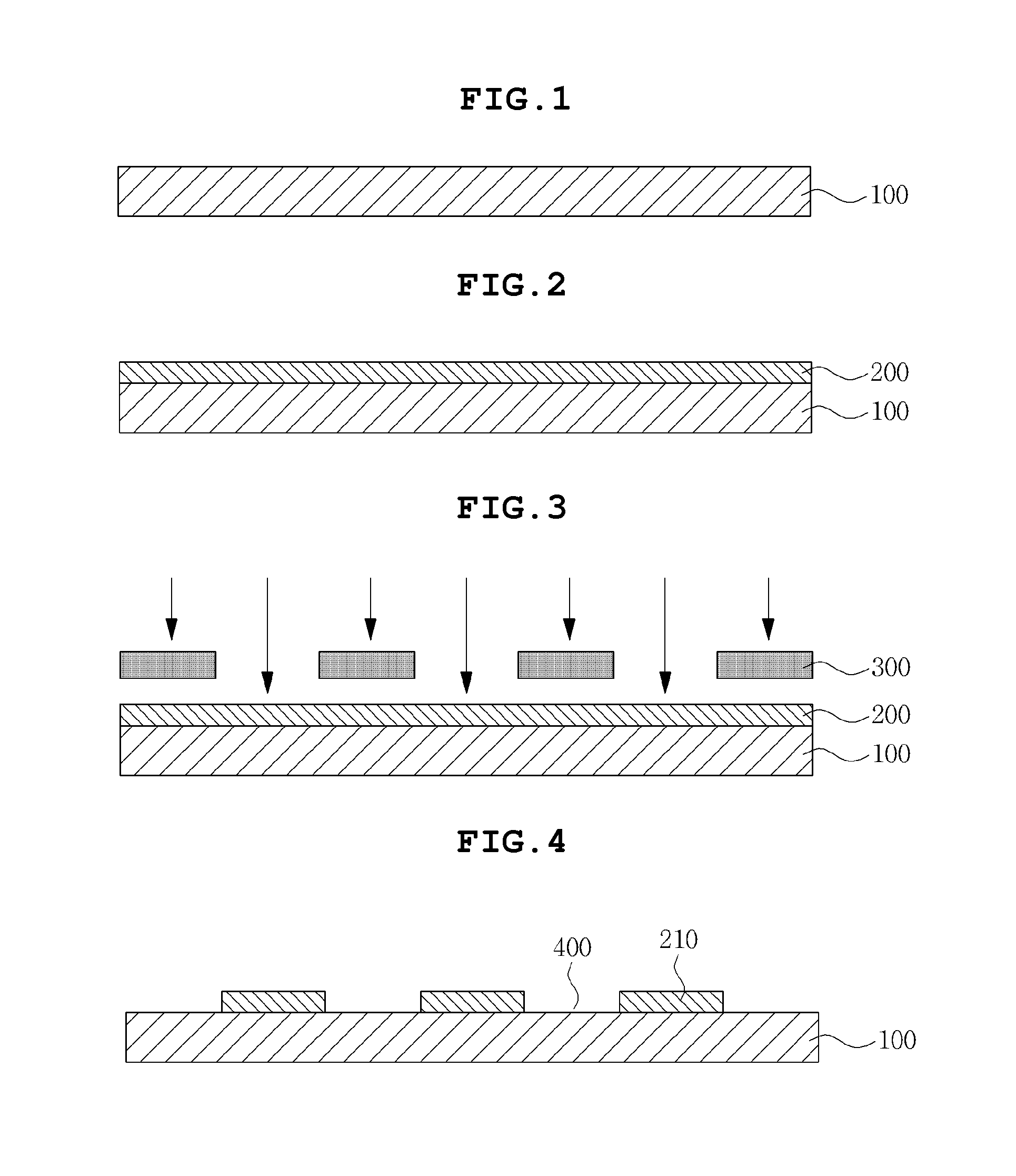Resin composition, printed circuit board using the composition, and method of manufacturing the same
a technology of composition and resin, which is applied in the direction of printing, electrography/magnetography, metal layered products, etc., can solve the problems of failure to recognize adhesion improvement, large amount of equipment and time, and inability to achieve excellent adhesion with a metal
- Summary
- Abstract
- Description
- Claims
- Application Information
AI Technical Summary
Benefits of technology
Problems solved by technology
Method used
Image
Examples
preparation example 1
Synthesis of 3-(1-methyl-1H-tetrazole-5-ylthio)propane-1-sulfonic acid
[0117]Acetonitrile of 90 g, 5-mercapto-1-methyltetrazole of 20 g (0.172 mol), and 1,3-propanesultone of 21 g (0.172 mol) were weighed, respectively, put into a 250 ml 1-neck flask having a reflux condenser mounted therein, and refluxed under nitrogen atmosphere at about 80° C. After an end point of the reaction was determined by a thin layer chromatography (TLC) (a development solvent chloroform:methanol=10:1) analysis and the reaction was terminated, Celite 545 was used to filter the reactant and filtrate was reduced-pressure concentrated, thereby obtaining 3-(1-methyl-1H-tetrazole-5-ylthio)propane-1-sulfonic acid using a silica column chromatography. A synthesis yield was 68%, and a melting point (DSC) was 98° C.
[0118]1H-NMR (CDCl3,δ) 3.63(s,3H,tetrazole-CH3), 3.40(t,2H,—S—CH2CH2CH2—SO3—) 2.95(t,2H,—S—CH2CH2CH3—SO3—), 2.20(m,2H,—S—CH2CH2CH3—SO3—)
preparation example 2
Preparation of Surface-Functionalized Silica
[0119]UFP30 (Denka Co., Ltd.) fused silica was dried in a dry oven at 120° C. for 3 or more hours, and then cooled up to room temperature in a desiccator to thereby remove moisture adsorbed in the silica. The moisture-removed silica of 50 g and dichloromethane of 500 g were put into a 1 liter flask and ultrasonic oscillation was used to disperse the silica well. After sodium ethoxide of 10 g was put thereinto, followed by stirring at a temperature of 40° C. for 2 hours, a silica powder was filtered by using a filter paper. After dichloromethane of 200 g and 3-(1-methyle-1H-tetrazole-5-ylthio)propane-1-sulfonic acid of 10 g obtained by Preparation Example 1 were put into the filtered silica powder, followed by stirring at room temperature for 5 hours, distilled water of 200 g was put thereto using a fractional funnel, thereby extracting sodium hydroxide as a reaction product. After the extraction was additionally repeated twice, the silica ...
example 1
[0121]After cresol novolac type acid-modified epoxy acrylate resin CCR-1171H (manufactured by Nippon Kayaku Co., Ltd.) of 92 g and Disper BYK-110 (manufactured by BYK Company) of 4.5 g were dissolved into methyl ethyl ketone (MEK) of 115 g, the surface-functionalized silica of 81.6 g obtained by Preparation Example 2 was put thereinto, followed by pre-distribution at 2000 rpm for 30 minutes using a homo-mixer and distribution for 1 hour using a beads mill. After bisphenol A type epoxy resin YD-011 (manufactured by Kukdo Chemical Co., Ltd.) of 26 g, a curing agent 2-ethyl-4-methylimidazole of 0.2 g, an acrylic resin Kayarad DPHA (manufactured by Nippon Kayaku Co., Ltd) of 7.6 g, a photoinitiator Irgacure 819 (manufactured by BASF Corporation) of 1.8 g, a photoinitiator Irgacure 184D (manufactured by BASF Corporation) of 1 g were dissolved into the dispersion composition to prepare a resin varnish, the resin varnish was coated on a polyethyleneterephthalate film having a thickness of ...
PUM
| Property | Measurement | Unit |
|---|---|---|
| Mass | aaaaa | aaaaa |
| Mass | aaaaa | aaaaa |
| Particle size | aaaaa | aaaaa |
Abstract
Description
Claims
Application Information
 Login to View More
Login to View More - R&D
- Intellectual Property
- Life Sciences
- Materials
- Tech Scout
- Unparalleled Data Quality
- Higher Quality Content
- 60% Fewer Hallucinations
Browse by: Latest US Patents, China's latest patents, Technical Efficacy Thesaurus, Application Domain, Technology Topic, Popular Technical Reports.
© 2025 PatSnap. All rights reserved.Legal|Privacy policy|Modern Slavery Act Transparency Statement|Sitemap|About US| Contact US: help@patsnap.com



